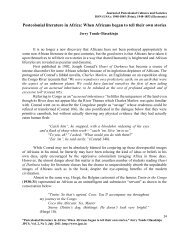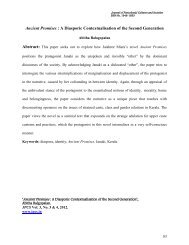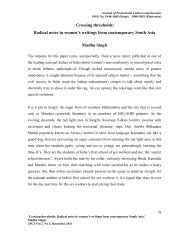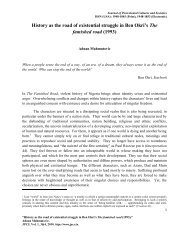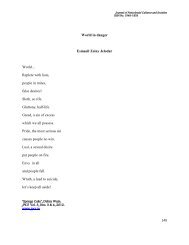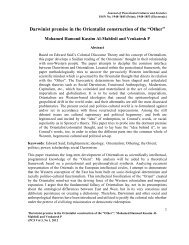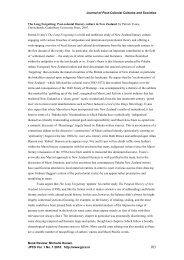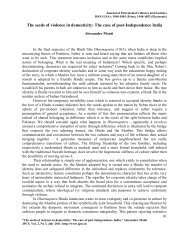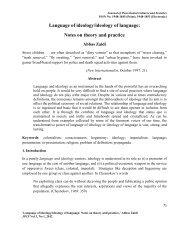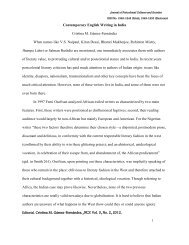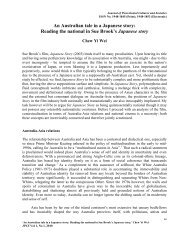(A Shuttle in the crypt)'JPCS'(1)
(A Shuttle in the crypt)'JPCS'(1)
(A Shuttle in the crypt)'JPCS'(1)
- No tags were found...
Create successful ePaper yourself
Turn your PDF publications into a flip-book with our unique Google optimized e-Paper software.
Journal of Postcolonial Cultures and SocietiesISSN No. 1948-1853The poet has an apprehension that his present <strong>in</strong>carceration might dra<strong>in</strong> off his strength andweaken his mental resolve to keep focus on his pr<strong>in</strong>ciple of stand<strong>in</strong>g on <strong>the</strong> path of truth <strong>in</strong> <strong>the</strong>face of tribulation as poignantly described <strong>in</strong> <strong>the</strong> poem. The only susta<strong>in</strong><strong>in</strong>g succour for <strong>the</strong> poetis his “roots”,and <strong>the</strong> poet craves for his “roots” to go deep down <strong>the</strong> earth to draw <strong>the</strong> muchneeded “susta<strong>in</strong><strong>in</strong>g draughts” which can only be gotten pure, clean and unpolluted when <strong>the</strong>“roots” goes deeper <strong>in</strong>to <strong>the</strong> ground to avoid distraction that could cause <strong>the</strong> roots to seek fortemporary supply of water which has been contam<strong>in</strong>ated, because such contam<strong>in</strong>ation ariseswhen “surface tunnels end <strong>in</strong> bl<strong>in</strong>ds …… courses/choke on silt, stagnate <strong>in</strong> human curses (1).The poet‟s request for his “roots” to get deeper <strong>in</strong>to <strong>the</strong> ground evokes imagery of roots andwater, and <strong>the</strong> poet juxtaposes his present condition <strong>in</strong> prison with <strong>the</strong> nature imagery of rootsand water. The „‟Roots‟‟ signifies a muse which <strong>the</strong> poet reaches out to, to ga<strong>in</strong> <strong>in</strong>ner strengthand alertness as to get attuned to his conf<strong>in</strong>ement, such signification is expressed <strong>in</strong> cont<strong>in</strong>uousflow of words and symbols strik<strong>in</strong>g <strong>in</strong> <strong>the</strong>ir sound and message by <strong>the</strong> poet to emphasize hisstate of depravity, and to seek emotional fortitude to confront <strong>the</strong> seem<strong>in</strong>g temptation andvulnerability which could make him compromise his stand aga<strong>in</strong>st <strong>in</strong>justice.„Roots‟ is mythologized as a phenomenon of depth of vision which revolves around anacknowledgement of <strong>the</strong> realities around him, which could weaken his sensitivity as to blur hisstoical, ideological position and sway him from fur<strong>the</strong>r pursuit of his political conviction.Roots serves as a mantra which provides emotional rejuvenation to <strong>the</strong> poet:‘Deconstruct<strong>in</strong>g Violence In The Shadow Of Death: Problematiz<strong>in</strong>g Nationhood <strong>in</strong> WoleSoy<strong>in</strong>ka's A <strong>Shuttle</strong> In <strong>the</strong> Crypt’, Niki Ay<strong>in</strong>gbe.JPCS Vol. 3, No. 3 & 4, 2012.www.jpcs.<strong>in</strong>50
Journal of Postcolonial Cultures and SocietiesISSN No. 1948-1853Roots, I pray you lead away from streamsOf ta<strong>in</strong>ted seepage lest I, of <strong>the</strong>se crimesPartake, from fouled communion (1).The poet‟s resolve to criticize <strong>the</strong> establishment is with <strong>the</strong> <strong>in</strong>tention of expos<strong>in</strong>g <strong>the</strong><strong>in</strong>herent ills and corruption <strong>in</strong> its fold, <strong>the</strong>se which he variously describes as “ta<strong>in</strong>ted seepage”,fouled communion”, and “baited stake”, are <strong>in</strong>fectious traits of corruption which <strong>the</strong> poet prays„Roots‟ to steer him away from. S<strong>in</strong>ce literature is a product of <strong>the</strong> social and historicalcircumstances of a particular society, a notion anchored on <strong>the</strong> Aristotelian position that societyitself is political, s<strong>in</strong>ce it <strong>in</strong>volves <strong>the</strong> organisation and <strong>the</strong> government of men. This Aristotelianposition resonates <strong>in</strong> A <strong>Shuttle</strong> <strong>in</strong> <strong>the</strong> Crypt, s<strong>in</strong>ce Soy<strong>in</strong>ka considers <strong>the</strong> exposition of sociopoliticalissues an important part of his role as a writer, is <strong>in</strong> conformity with <strong>the</strong> view of Irv<strong>in</strong>gHowe who observes that,‟‟ literature provides a particularly severe test for <strong>the</strong> writer <strong>in</strong>confront<strong>in</strong>g <strong>in</strong>stitutionalised social vices. It arouses human passions as noth<strong>in</strong>g else does andwhatever we may consent to overlook <strong>in</strong> read<strong>in</strong>g a novel, we react to, <strong>in</strong> <strong>the</strong> physical sociopoliticalcircumstances‟‟ (25).This is fur<strong>the</strong>r reverberated <strong>in</strong> Ngugi‟s sem<strong>in</strong>al book, Writers <strong>in</strong>Politics, which succ<strong>in</strong>ctly illustrates <strong>the</strong> relationship between a writer and his society, Ngugi <strong>in</strong><strong>the</strong> book enthuses that, ‟‟literature does not grow or develop <strong>in</strong> vacuum; it is given impetus,shape, direction and concern by <strong>the</strong> social, political and economic forces <strong>in</strong> a particular society‟‟(xv).There can be no doubt that <strong>the</strong> relationship between literature and society is so close as to be‘Deconstruct<strong>in</strong>g Violence In The Shadow Of Death: Problematiz<strong>in</strong>g Nationhood <strong>in</strong> WoleSoy<strong>in</strong>ka's A <strong>Shuttle</strong> In <strong>the</strong> Crypt’, Niki Ay<strong>in</strong>gbe.JPCS Vol. 3, No. 3 & 4, 2012.www.jpcs.<strong>in</strong>51
Journal of Postcolonial Cultures and SocietiesISSN No. 1948-1853virtually symbiotic, however, <strong>the</strong> notion of <strong>the</strong> significance of social relevance <strong>in</strong> literature is adebatable one. This is because it lends itself to a wide variety of def<strong>in</strong>itions, ideological positionsand sundry biases, many of which are diametrically opposed to one ano<strong>the</strong>r. For religious bodies,for <strong>in</strong>stance, social relevance <strong>in</strong> literature would be closely related to literature‟s positive moraloutlook and its didactic elements; for those <strong>in</strong> positions of social and political dom<strong>in</strong>ance, socialrelevance <strong>in</strong> literature would basically mean <strong>the</strong> extent to which it upholds <strong>the</strong> stability of <strong>the</strong>exist<strong>in</strong>g socio-political order; for those who are committed to <strong>the</strong> radical change of exist<strong>in</strong>gpolitical systems, social relevance <strong>in</strong> literature would relate to <strong>the</strong> way <strong>in</strong> which it del<strong>in</strong>eates <strong>the</strong>flaws and shortcom<strong>in</strong>gs of current social and political processes, and explicitly advocates <strong>the</strong>irreplacement. Similarly, m<strong>in</strong>orities and oppressed groups <strong>in</strong> any given society are very likely tobase <strong>the</strong>ir notions of social relevance <strong>in</strong> literature upon <strong>the</strong> manner <strong>in</strong> which it is able to portray<strong>the</strong>m and highlight issues which are germane to <strong>the</strong>m. Iyorchia Ayu <strong>in</strong> fur<strong>the</strong>r pursuit of socialrelevance <strong>in</strong> literature, has affirmed that:literature for <strong>the</strong> class <strong>in</strong> dom<strong>in</strong>ance, is an extra tool for concretis<strong>in</strong>g hegemony.For <strong>the</strong> subord<strong>in</strong>ate class, however, literature must aim at conquer<strong>in</strong>g man‟salienation, pav<strong>in</strong>g <strong>the</strong> way for <strong>the</strong> liberation of his <strong>in</strong>hibited creativity andultimately <strong>the</strong> restoration of his full human dignity. (3)Soy<strong>in</strong>ka <strong>in</strong> A <strong>Shuttle</strong> <strong>in</strong> <strong>the</strong> Crypt, writes with <strong>the</strong> understand<strong>in</strong>g that art must first seek to‘Deconstruct<strong>in</strong>g Violence In The Shadow Of Death: Problematiz<strong>in</strong>g Nationhood <strong>in</strong> WoleSoy<strong>in</strong>ka's A <strong>Shuttle</strong> In <strong>the</strong> Crypt’, Niki Ay<strong>in</strong>gbe.JPCS Vol. 3, No. 3 & 4, 2012.www.jpcs.<strong>in</strong>52
Journal of Postcolonial Cultures and SocietiesISSN No. 1948-1853transform society‟s dehumanis<strong>in</strong>g conditions if it is to establish a system <strong>in</strong> which humanity cangive free re<strong>in</strong> to its self-expression, self-fulfilment and maximum self-realisation. His convictionis foregrounded on <strong>the</strong> notion that when art runs counter to <strong>the</strong> <strong>in</strong>terest of <strong>the</strong> dom<strong>in</strong>ant class <strong>in</strong>society, <strong>the</strong> attitude of that class to art changes. This notion reiterates Vazquez‟s observationthat:Art shares its dest<strong>in</strong>y with <strong>the</strong> social forces which are struggl<strong>in</strong>g to resolve <strong>the</strong>contradictions rend<strong>in</strong>g both society and <strong>the</strong> <strong>in</strong>dividual between true communityand true <strong>in</strong>dividuality. Therefore, <strong>the</strong> heroic rebellion of <strong>the</strong> modern artist need nolonger have <strong>the</strong> exclusive and impudent character it had when he was consideredan outcast. (33)Howe is also of <strong>the</strong> op<strong>in</strong>ion that, ‟‟literature tries to provide a faithful record of all happen<strong>in</strong>gsand sentiments which comprise ord<strong>in</strong>ary life‟‟ (x),he fur<strong>the</strong>r argues that literature <strong>in</strong> its pragmaticdevotion to <strong>the</strong> commonplace is regularly drawn to <strong>the</strong> test of extreme situations, <strong>the</strong> drama ofharsh and ultimate conflicts. In <strong>the</strong> same ve<strong>in</strong>, Ezekiel Fajenyo and Olu Osunde stress that:Nigerian and o<strong>the</strong>r African writers <strong>in</strong> whatever literary genre which <strong>the</strong>y havechosen to project <strong>the</strong>ir visions cannot but be largely <strong>in</strong>fluenced by <strong>the</strong> wave ofsocio-political awareness forcefully attendant on <strong>the</strong> prevail<strong>in</strong>g socio-politicaldilemma which is <strong>the</strong> picture of experienced gloom with<strong>in</strong> <strong>the</strong> social milieu. The‘Deconstruct<strong>in</strong>g Violence In The Shadow Of Death: Problematiz<strong>in</strong>g Nationhood <strong>in</strong> WoleSoy<strong>in</strong>ka's A <strong>Shuttle</strong> In <strong>the</strong> Crypt’, Niki Ay<strong>in</strong>gbe.JPCS Vol. 3, No. 3 & 4, 2012.www.jpcs.<strong>in</strong>53
Journal of Postcolonial Cultures and SocietiesISSN No. 1948-1853sensibility of <strong>the</strong> writer cannot be imp<strong>in</strong>ged upon <strong>in</strong> his capacity as a visionary byvary<strong>in</strong>g degrees of frighten<strong>in</strong>g tribulations to which most African countries haves<strong>in</strong>ce become exposed, not so much for colonial experience, as for <strong>the</strong> totalabsence of political seriousness, economic sureness and consciousness with<strong>in</strong> <strong>the</strong>social structure bereft of democratic ideals. (20)From <strong>the</strong> forego<strong>in</strong>g, Soy<strong>in</strong>ka <strong>in</strong> A <strong>Shuttle</strong> <strong>in</strong> <strong>the</strong> Crypt doggedly articulates <strong>the</strong> political, socialand economic problems which have beset Nigeria over <strong>the</strong> past decades, this has a corollary <strong>in</strong><strong>the</strong> observation of Thomas Knipp who states that, ‟‟<strong>in</strong>tellectuals have a strong voice <strong>in</strong> shap<strong>in</strong>gnational and cont<strong>in</strong>ental realities. They are, after all, part of <strong>the</strong> rul<strong>in</strong>g elite, sometimes policyshapersof cab<strong>in</strong>et rank, sometimes voices of cab<strong>in</strong>et rank, sometimes voices of opposition. Theirvoices are heard, and beh<strong>in</strong>d <strong>the</strong>ir words lie <strong>the</strong> important African realities‟‟(39).Soy<strong>in</strong>ka‟s <strong>in</strong>carceration was done by <strong>the</strong> government with <strong>the</strong> <strong>in</strong>tention of break<strong>in</strong>g himpsychologically as to wean him off radical postur<strong>in</strong>g, yet by a strange irony, it was precisely <strong>in</strong>this prison that a new brand of radicalism and socio-political consciousness was given impetus.The criticism of conf<strong>in</strong>ement of an artist <strong>in</strong> prison without trial is an important <strong>in</strong>dicator of <strong>the</strong>extent of awaken<strong>in</strong>g by <strong>the</strong> African writers to historical realities that l<strong>in</strong>k nationhood to violence<strong>in</strong> post colonial Africa. More precisely <strong>in</strong> A <strong>Shuttle</strong> <strong>in</strong> <strong>the</strong> Crypt, Soy<strong>in</strong>ka reveals <strong>the</strong> depth of his<strong>in</strong>sight <strong>in</strong> decipher<strong>in</strong>g a Nigerian history impr<strong>in</strong>ted with brutality and subjugation, by articulat<strong>in</strong>ghis conf<strong>in</strong>ement Soy<strong>in</strong>ka has helped extricate state sponsored violence from historical myth and‘Deconstruct<strong>in</strong>g Violence In The Shadow Of Death: Problematiz<strong>in</strong>g Nationhood <strong>in</strong> WoleSoy<strong>in</strong>ka's A <strong>Shuttle</strong> In <strong>the</strong> Crypt’, Niki Ay<strong>in</strong>gbe.JPCS Vol. 3, No. 3 & 4, 2012.www.jpcs.<strong>in</strong>54
Journal of Postcolonial Cultures and SocietiesISSN No. 1948-1853<strong>in</strong>scribe it <strong>in</strong> history. Soy<strong>in</strong>ka‟s representation of violence is made palpable <strong>in</strong> “To <strong>the</strong> Madmenover <strong>the</strong> wall”, here <strong>the</strong> poet has conquered fear, <strong>the</strong> politics of fear are replaced by <strong>the</strong> politicsof confrontation, as his imprisonment hasturned <strong>the</strong> tables on <strong>the</strong> authorities. Soy<strong>in</strong>ka‟slanguage has become more fierce and acerbic <strong>in</strong> speak<strong>in</strong>g truth to his oppressors, to <strong>the</strong> extentthat his language has acquired an elan of superiority, grounded <strong>in</strong> <strong>the</strong> use of powerful imagerywhose gusto defies all restra<strong>in</strong>ts of artistic creation:I fearYour m<strong>in</strong>ds have dared <strong>the</strong> <strong>in</strong>f<strong>in</strong>iteAnd journeyed backTo speak <strong>in</strong> foreign tongues (18)Though wallsMay rupture tired seamsOf <strong>the</strong> magic cloak we share, yetCloser I may not comeBut though I set my ear aga<strong>in</strong>stThe tune of sett<strong>in</strong>g forth, yet, howlUpon <strong>the</strong> hour of sleep, tell <strong>the</strong>se wallsThe human heart may holdOnly so much despair (18).The poet has now taken up <strong>the</strong> role of a spokesman of <strong>the</strong> deranged and madmen, it islamentable <strong>in</strong> <strong>the</strong> poem, that <strong>the</strong> prison experience seems to have weakened <strong>the</strong> poet aspresented here. But despite <strong>the</strong> discernible tremolo <strong>in</strong> <strong>the</strong> poet‟s voice, one could still notice avibrant camaraderie between <strong>the</strong> poet and <strong>the</strong> madmen. The poet demands <strong>the</strong> unity of allprisoners as <strong>the</strong> tonic required to confront <strong>the</strong>ir oppressors, this wake-up call is not only draw<strong>in</strong>gour attention to <strong>the</strong> collective plight of <strong>the</strong> prisoners, but it is also call<strong>in</strong>g attention to <strong>the</strong>frustration experienced by <strong>the</strong> prisoners which is almost driv<strong>in</strong>g <strong>the</strong>m to a deep-seated <strong>in</strong>sanity:‘Deconstruct<strong>in</strong>g Violence In The Shadow Of Death: Problematiz<strong>in</strong>g Nationhood <strong>in</strong> WoleSoy<strong>in</strong>ka's A <strong>Shuttle</strong> In <strong>the</strong> Crypt’, Niki Ay<strong>in</strong>gbe.JPCS Vol. 3, No. 3 & 4, 2012.www.jpcs.<strong>in</strong>55
Journal of Postcolonial Cultures and SocietiesISSN No. 1948-1853closer I may not comeThe tune of sett<strong>in</strong>g forth, yet, howlUpon <strong>the</strong> hour of sleep, tell <strong>the</strong>se wallsThe human heart may holdOnly so much despair (18).These l<strong>in</strong>es quizzically comb<strong>in</strong>e <strong>the</strong> magnitude of desperation of <strong>in</strong>mates to break from <strong>the</strong>loop,this collective anger of <strong>the</strong> <strong>in</strong>mates is directed at <strong>the</strong> rot, dilapidation and dearth ofpurposeful vision <strong>in</strong> all spheres of governance <strong>in</strong> Nigeria: justice, hospital, prisons and o<strong>the</strong>rgovernment agencies, which elicit frustration, disillusionment and lack ofpatriotism, forNigeria‟s nationhood. The rhythm of <strong>the</strong> poem bemoans dejection, loss and neglect whichreveals <strong>the</strong> know<strong>in</strong>gness and awareness of <strong>the</strong> decrepit state of Nigerian prison, capable ofdestroy<strong>in</strong>g <strong>in</strong>mates‟ sanity.Decry<strong>in</strong>g Poetics of Violence <strong>in</strong> Nigeria’s NationhoodContrary to <strong>the</strong> notion that violence is an exclusive weapon of <strong>the</strong> colonial authority, butwith <strong>the</strong> atta<strong>in</strong>ment of <strong>in</strong>dependence by Nigeria <strong>in</strong> 1960, violence dangerously crept <strong>in</strong>to itslandscape as a result of ethnic rivalries and tensions. This notion, with its chronological frame ofreference is what constitutes <strong>the</strong> epitome of abjection and horror <strong>in</strong> <strong>the</strong> portrayal of violence <strong>in</strong>post-colonial Nigeria as grounded <strong>in</strong> <strong>the</strong> poetics of A <strong>Shuttle</strong> <strong>in</strong> <strong>the</strong> Crypt. The politics ofviolence <strong>in</strong> Nigeria‟s nationhood is critically pursued <strong>in</strong> “Conversation at night with aCockroach”, and has a parallelism <strong>in</strong> “October 66 “poems of Idanre‟‟, where <strong>the</strong> knotty issue of‘Deconstruct<strong>in</strong>g Violence In The Shadow Of Death: Problematiz<strong>in</strong>g Nationhood <strong>in</strong> WoleSoy<strong>in</strong>ka's A <strong>Shuttle</strong> In <strong>the</strong> Crypt’, Niki Ay<strong>in</strong>gbe.JPCS Vol. 3, No. 3 & 4, 2012.www.jpcs.<strong>in</strong>56
Journal of Postcolonial Cultures and SocietiesISSN No. 1948-18531966 pogrom is revisited. A lot of Nigerians of Igbo extraction were gruesomely murdered anddecapitated <strong>in</strong> Nor<strong>the</strong>rn Nigeria dur<strong>in</strong>g <strong>the</strong> pogrom. Soy<strong>in</strong>ka <strong>in</strong> <strong>the</strong> poem condemned thisatrocious kill<strong>in</strong>g, which forever rema<strong>in</strong>s a haunt<strong>in</strong>g historical reference <strong>in</strong> <strong>the</strong> tortured andturbulent post <strong>in</strong>dependent Nigeria‟s history. The 1966 political crisis helps expla<strong>in</strong> Nigeria as afixed physical space, an artificial structure vulnerable to construction and reconstruction by itspolitical elite. This notion accentuates Ilana Pardes‟ <strong>the</strong>sis of a nation as an „„imag<strong>in</strong>edconstruct‟‟ or an „„<strong>in</strong>scape ra<strong>the</strong>r than a landscape of national identity‟‟(9). This correspondswith Rhonda Cobhan‟s perception of a nation as‟‟ hav<strong>in</strong>g a shift<strong>in</strong>g and unstable significancewith<strong>in</strong> African political discourse‟‟(84). The poem affords <strong>the</strong> poet to recall <strong>in</strong> tranquility of hisprison conf<strong>in</strong>ement, that <strong>the</strong> destruction of human lives and properties <strong>in</strong> 1966 political crisisunderscores Nigeria as a wishful th<strong>in</strong>k<strong>in</strong>g and a mere conjecture, whose shape and sphere can bearranged and rearranged at will by its political leadership. The tension between <strong>the</strong> need for <strong>the</strong>poet to come to grip with his solitary conf<strong>in</strong>ement and <strong>the</strong> need to reflect on Nigerian nationhoodis developed gradually through <strong>the</strong> recollection of violent scenarios orchestrated by <strong>the</strong> 1966political crisis. The poet identifies and situate himself emotionally with <strong>the</strong> dilemma of people,of Igbo extraction stranded <strong>in</strong> nor<strong>the</strong>rn Nigeria, hi<strong>the</strong>rto who had never known of any o<strong>the</strong>rhome apart from <strong>the</strong>ir nor<strong>the</strong>rn Nigeria abode:And we had sojourned long amongour violators, generations of far-flungclans, and taken wives among <strong>the</strong>m‘Deconstruct<strong>in</strong>g Violence In The Shadow Of Death: Problematiz<strong>in</strong>g Nationhood <strong>in</strong> WoleSoy<strong>in</strong>ka's A <strong>Shuttle</strong> In <strong>the</strong> Crypt’, Niki Ay<strong>in</strong>gbe.JPCS Vol. 3, No. 3 & 4, 2012.www.jpcs.<strong>in</strong>57
Journal of Postcolonial Cultures and SocietiesISSN No. 1948-1853and given daughters unto <strong>the</strong>m for wivesour offspr<strong>in</strong>g knew no land but thisNo air/no earth, no loves or deathonly <strong>the</strong> brittle sky <strong>in</strong> harmattan (8).The poet‟s identification with <strong>the</strong> persecuted people of Igbo extraction, fur<strong>the</strong>r reiterates <strong>the</strong>social relevance of <strong>the</strong> artist as a member of <strong>the</strong> society, as a member of <strong>the</strong> society, <strong>the</strong> artist isexpected to focus on <strong>the</strong> prevail<strong>in</strong>g situation of his society as to elicit its cont<strong>in</strong>ued function<strong>in</strong>gand progress. At its most fundamental, <strong>the</strong>refore, social relevance <strong>in</strong> literature is said to refer to<strong>the</strong> complex ways <strong>in</strong> which <strong>the</strong> form, function and purpose of literature, however def<strong>in</strong>ed, are<strong>in</strong>extricably <strong>in</strong>terwoven with <strong>the</strong> growth, progress and stability of society. The very phrase“social relevance” assumes that such a relationship is a default sett<strong>in</strong>g for any literature whichdeems itself worthy of <strong>the</strong> name, and by implication would condemn any literature <strong>in</strong> which thisrelationship is absent, or even <strong>in</strong>directly stated. Social relevance, from this perspective, wouldseem to imply that literature has a duty to make <strong>the</strong> progress of society a card<strong>in</strong>al objective,regardless of whatever else it may seek to achieve. It is this conviction that has succ<strong>in</strong>ctly<strong>in</strong>formed Soy<strong>in</strong>ka‟s unobtrusive representation of ethnic chauv<strong>in</strong>ism as a major flaw <strong>in</strong> Nigeria‟snationhood, <strong>in</strong> which <strong>the</strong> people of Igbo extraction suffered as its casualty. It is practicallyimpossible to discuss literature without mak<strong>in</strong>g reference to society, as René Wellek and Aust<strong>in</strong>Warren have stressed <strong>the</strong> very close relationship between <strong>the</strong> two:Literature is a social <strong>in</strong>stitution, us<strong>in</strong>g as its medium language, a social creation.Such traditional literary devices as symbolism and metre are social <strong>in</strong> <strong>the</strong>ir very‘Deconstruct<strong>in</strong>g Violence In The Shadow Of Death: Problematiz<strong>in</strong>g Nationhood <strong>in</strong> WoleSoy<strong>in</strong>ka's A <strong>Shuttle</strong> In <strong>the</strong> Crypt’, Niki Ay<strong>in</strong>gbe.JPCS Vol. 3, No. 3 & 4, 2012.www.jpcs.<strong>in</strong>58
Journal of Postcolonial Cultures and SocietiesISSN No. 1948-1853nature. They are conventions and norms which could have arisen only <strong>in</strong> society.But, fur<strong>the</strong>rmore, literature „represents‟ „life‟; and „life‟ is, <strong>in</strong> large measure, asocial reality, even though <strong>the</strong> natural world and <strong>the</strong> <strong>in</strong>ner or subjective world of<strong>the</strong> <strong>in</strong>dividual have also been objects of literary „imitation‟. The poet himself is amember of society, possessed of a specific social status: he receives some degreeof social recognition and reward; he addresses an audience however hypo<strong>the</strong>tical.Indeed, literature has usually arisen <strong>in</strong> close connexion with particular social<strong>in</strong>stitutions; and <strong>in</strong> primitive society we may even be unable to dist<strong>in</strong>guish poetryfrom ritual, magic, work, or play. Literature also has a social function, or „use‟,which cannot be purely <strong>in</strong>dividual. (94)This notion of literature has been vigorously defended <strong>in</strong> different literary eras <strong>in</strong> widelydispersed regions of <strong>the</strong> world: <strong>the</strong> overt morality of <strong>the</strong> satire-ridden Augustan Age <strong>in</strong> England,and <strong>the</strong> aggressive nationalism of <strong>the</strong> Harlem Renaissance <strong>in</strong> <strong>the</strong> United States and <strong>the</strong> Negritudemovement <strong>in</strong> sub-Saharan Africa and <strong>the</strong> Caribbean islands are obvious examples of <strong>the</strong>closeness between literature and society. Due to its repeatedly-tragic history, with its narrative ofslavery, colonialism and neo-colonialism, it is perhaps <strong>in</strong>evitable that modern African literatureis highly attuned to <strong>the</strong> requirements of contemporary African society as argued by S.E. Ogudewhen he op<strong>in</strong>es that:<strong>the</strong> history of contemporary African literature is <strong>the</strong> story of <strong>the</strong> black man‟s‘Deconstruct<strong>in</strong>g Violence In The Shadow Of Death: Problematiz<strong>in</strong>g Nationhood <strong>in</strong> WoleSoy<strong>in</strong>ka's A <strong>Shuttle</strong> In <strong>the</strong> Crypt’, Niki Ay<strong>in</strong>gbe.JPCS Vol. 3, No. 3 & 4, 2012.www.jpcs.<strong>in</strong>59
Journal of Postcolonial Cultures and SocietiesISSN No. 1948-1853attempt to reassert his political rights and defend <strong>the</strong> <strong>in</strong>tegrity of his culture andre-assess his past relationship with Europe and <strong>the</strong> many political and social<strong>in</strong>stitutions which <strong>the</strong> white man has imposed on <strong>the</strong> African. (3)Gareth Griffiths has made similar claims for <strong>the</strong> explicit utility of writ<strong>in</strong>g <strong>in</strong> contemporaryAfricathat,‟‟writ<strong>in</strong>g is an activity through which <strong>the</strong> African can def<strong>in</strong>e his identity and rediscoverhis historical roots. This self-def<strong>in</strong><strong>in</strong>g function of <strong>the</strong> writer and literature is for obviousreasons, especially important to writers <strong>in</strong> post-colonial situation…‟‟(68).The rhythm of “Conversation at night with a cockroach‟‟ is animated by <strong>the</strong> nuances of<strong>the</strong> nor<strong>the</strong>rn topography represented <strong>in</strong> <strong>the</strong> staccato of „baobab‟ and groundnut which betrays<strong>the</strong> grassland of <strong>the</strong> nor<strong>the</strong>rn part of Nigeria, „muezz<strong>in</strong>s,and „ m<strong>in</strong>arets‟ which typifyappurtenances of Islamic faith which is <strong>the</strong> predom<strong>in</strong>ant religion <strong>in</strong> <strong>the</strong> nor<strong>the</strong>rn Nigeria. Thepoem castigates and condemns <strong>the</strong> kill<strong>in</strong>g of <strong>the</strong> Igbos by <strong>the</strong>ir hausa-Fulani hosts as a violationof bond of hospitality prevalent <strong>in</strong> African cultural ethos. Such violation is repudiated by <strong>the</strong>poet, <strong>in</strong> his empathy with <strong>the</strong> victims of <strong>the</strong> massacre, while <strong>the</strong> cockroach speaks for <strong>the</strong>perpetrators of <strong>the</strong> mass kill<strong>in</strong>gs of <strong>the</strong> Igbo <strong>in</strong> <strong>the</strong> north. The cockroach justifies andrationalizes <strong>the</strong> kill<strong>in</strong>g as a gratification “… to rejuvenate mo<strong>the</strong>rs of-all earth. The cockroachfur<strong>the</strong>r valorizes this macabre when it enthuses that “we nibble blood before it cakes”. Soy<strong>in</strong>ka‟s‘Deconstruct<strong>in</strong>g Violence In The Shadow Of Death: Problematiz<strong>in</strong>g Nationhood <strong>in</strong> WoleSoy<strong>in</strong>ka's A <strong>Shuttle</strong> In <strong>the</strong> Crypt’, Niki Ay<strong>in</strong>gbe.JPCS Vol. 3, No. 3 & 4, 2012.www.jpcs.<strong>in</strong>60
Journal of Postcolonial Cultures and SocietiesISSN No. 1948-1853representation of violence <strong>in</strong> <strong>the</strong> massacre of <strong>the</strong> Igbo by <strong>the</strong>ir Hausa hosts <strong>in</strong> nor<strong>the</strong>rn Nigeria,underscores Richard K. Priebe‟s view on <strong>the</strong> representation of violence <strong>in</strong> literature:In African literature, we are essentially look<strong>in</strong>g at how literature of violenceSucceeds or fails as art. In broad human terms, representations of violence <strong>in</strong> anyLiterature, as <strong>in</strong> life, may do one of three th<strong>in</strong>gs: <strong>the</strong>y may overwhelm us with a senseOf <strong>the</strong> banality of violence, <strong>the</strong>y may impress <strong>in</strong> us our capacity for <strong>the</strong> demonic, or <strong>the</strong>ymay serve to leave us with some sense of <strong>the</strong> sublime. The banal, <strong>the</strong> demonic, and <strong>the</strong>sublime, however are not easily separated <strong>in</strong> our daily lives.(47)Soy<strong>in</strong>ka‟s representation of <strong>the</strong> orgy of violence <strong>in</strong> <strong>the</strong> poem takes on <strong>the</strong> task of<strong>in</strong>terrogat<strong>in</strong>g <strong>the</strong> underl<strong>in</strong>e colonial imperative which <strong>in</strong>formed <strong>the</strong> yok<strong>in</strong>g toge<strong>the</strong>r of differentethnic groups with conflict<strong>in</strong>g <strong>in</strong>terests <strong>in</strong> Nigeria‟s nationhood. For Soy<strong>in</strong>ka, memory of <strong>the</strong>1966 pogrom is portentously daunt<strong>in</strong>g <strong>in</strong> two respects: first, for <strong>the</strong> people of Igbo extraction, <strong>the</strong>choice is between <strong>the</strong>rapeutic amnesia or traumatic memory, none of which obliterates scar of<strong>the</strong> terrify<strong>in</strong>g horror <strong>the</strong>y have been subjected to, and experienced first hand. Second, memory of<strong>the</strong> loss of <strong>the</strong>ir loved ones and <strong>the</strong>ir properties dur<strong>in</strong>g <strong>the</strong> crisis, becomes a haunt<strong>in</strong>g burdenwhich is forever <strong>in</strong>scribed <strong>in</strong> <strong>the</strong>ir collective psyche. The horror of <strong>the</strong> pogrom is fur<strong>the</strong>rreiterated with <strong>the</strong> serialization and catalogu<strong>in</strong>g of its atrocities represented <strong>in</strong> <strong>the</strong> poem:… nor was death withheldEven from children, from <strong>the</strong> unborn.‘Deconstruct<strong>in</strong>g Violence In The Shadow Of Death: Problematiz<strong>in</strong>g Nationhood <strong>in</strong> WoleSoy<strong>in</strong>ka's A <strong>Shuttle</strong> In <strong>the</strong> Crypt’, Niki Ay<strong>in</strong>gbe.JPCS Vol. 3, No. 3 & 4, 2012.www.jpcs.<strong>in</strong>61
Journal of Postcolonial Cultures and SocietiesISSN No. 1948-1853And wombs were torn from liv<strong>in</strong>g womenAnd eyes of children taken outOn <strong>the</strong> po<strong>in</strong>ts of knives and bayonets.The sky was blotted out <strong>in</strong> funeral pyresAnd <strong>the</strong> faggots were limbs of <strong>the</strong> liv<strong>in</strong>g.There was no sanctuary, <strong>in</strong> mosque or chapel,In surgeries, where we fled for heal<strong>in</strong>g hands,On grave step or <strong>in</strong> cradle…And many drew last breathBeneath <strong>the</strong> earth, below corrupted water. (10-11)This is a pa<strong>the</strong>tic situation which renders a scenario of war situation less grim and lessdevastat<strong>in</strong>g, propensity for mass kill<strong>in</strong>g did not even deter <strong>the</strong> perpetrators of this he<strong>in</strong>ous actfrom respect<strong>in</strong>g <strong>the</strong> sanctity of sacred places like <strong>the</strong> mosque or chapel where <strong>the</strong>y still hunteddown and killed <strong>the</strong>ir victims who have sought refuge <strong>in</strong> <strong>the</strong>se sacred places, th<strong>in</strong>k<strong>in</strong>g that byseek<strong>in</strong>g solace <strong>in</strong> <strong>the</strong>se sacred places <strong>the</strong>y will be free from <strong>the</strong> long hands of <strong>the</strong>se killers.Nigeria‟s nationhood is often bogged down by ethnicity which is significantly portrayed as amajor <strong>in</strong>dex of under development <strong>in</strong> <strong>the</strong> poem, hence, eth<strong>in</strong>ic chauv<strong>in</strong>ism subsists an albatross<strong>in</strong> Nigeria‟s quest for political stability. In represent<strong>in</strong>g <strong>the</strong> consequences of ethnic rivalry <strong>in</strong>post-colonial Nigeria as established <strong>in</strong> <strong>the</strong> poetics of A <strong>Shuttle</strong> <strong>in</strong> <strong>the</strong> Crypt, Soy<strong>in</strong>ka blurs <strong>the</strong>dichotomy between history and literature, given <strong>the</strong> fact that both often appear <strong>in</strong> textual form,and are grouped <strong>in</strong>to a hierarchical structure, <strong>in</strong> which <strong>the</strong>ir <strong>in</strong>terpretation is often regarded as <strong>the</strong>provenance of so- called specialists whose competence to <strong>in</strong>terpret <strong>the</strong>m usually goes‘Deconstruct<strong>in</strong>g Violence In The Shadow Of Death: Problematiz<strong>in</strong>g Nationhood <strong>in</strong> WoleSoy<strong>in</strong>ka's A <strong>Shuttle</strong> In <strong>the</strong> Crypt’, Niki Ay<strong>in</strong>gbe.JPCS Vol. 3, No. 3 & 4, 2012.www.jpcs.<strong>in</strong>62
Journal of Postcolonial Cultures and SocietiesISSN No. 1948-1853unquestioned. As Leonee Ormond has po<strong>in</strong>ted out, <strong>the</strong> closeness of history and literature <strong>in</strong> <strong>the</strong>past is an <strong>in</strong>dication of <strong>the</strong>ir conceptual similarity,‟‟ Literature and history are k<strong>in</strong>dred forms.Indeed, as late as <strong>the</strong> eighteenth century, history was regarded as a literary art. Both literatureand history are narrative structures concerned with <strong>the</strong> behaviour of human be<strong>in</strong>gs and with <strong>the</strong>passage of time…‟‟(1).Poetics of Nigeria‟s nationhood and political rivalry among its constituent ethnic groups areessentially grounded <strong>in</strong> <strong>the</strong> mediation between historical events and <strong>the</strong>ir imag<strong>in</strong>ativerepresentation. Soy<strong>in</strong>ka essentially sets up a contrast between what is deemed to have occurred<strong>in</strong> history and his approach to it <strong>in</strong> A <strong>Shuttle</strong> <strong>in</strong> <strong>the</strong> Crypt. Histrionic of <strong>the</strong> ambivalence <strong>in</strong>Nigeria‟s nationhood, remarkably constitute <strong>the</strong> narrative locales of <strong>the</strong> “Four archetypes” ofJoseph, Hamlet, Gulliver and Ulysses, which collectively provides a convenient mask for <strong>the</strong>poet to reflect on his experiences <strong>in</strong> <strong>the</strong> prison dur<strong>in</strong>g <strong>the</strong> Nigerian civil war. Just like <strong>the</strong> poet,<strong>the</strong> four archetypes are victims of orchestrated manipulations, because <strong>the</strong>y are embodimentsof pr<strong>in</strong>ciple, courage and perseverance. They all had brushes with <strong>the</strong> establishment foridentify<strong>in</strong>g with truth and ideals, and for speak<strong>in</strong>g truth to power, Joseph and Gulliver areimprisoned, Ulysses is deta<strong>in</strong>ed and Hamlet is exiled to England. Soy<strong>in</strong>ka sees <strong>in</strong> <strong>the</strong>se forarchetypes, models of truth, and consistency <strong>in</strong> uphold<strong>in</strong>g <strong>the</strong> truth by <strong>in</strong>ternaliz<strong>in</strong>g <strong>the</strong>irexperiences. The poet uses such experiences to buoy his mood and to conv<strong>in</strong>ce himself that <strong>the</strong>‘Deconstruct<strong>in</strong>g Violence In The Shadow Of Death: Problematiz<strong>in</strong>g Nationhood <strong>in</strong> WoleSoy<strong>in</strong>ka's A <strong>Shuttle</strong> In <strong>the</strong> Crypt’, Niki Ay<strong>in</strong>gbe.JPCS Vol. 3, No. 3 & 4, 2012.www.jpcs.<strong>in</strong>63
Journal of Postcolonial Cultures and SocietiesISSN No. 1948-1853attendant manifestations of his <strong>in</strong>carceration: alienation, persecution, pa<strong>in</strong> and conf<strong>in</strong>ement are<strong>the</strong> fallouts of <strong>the</strong> dividends of speak<strong>in</strong>g truth to power.“Joseph” is <strong>in</strong>debted to <strong>the</strong> story of Joseph and <strong>the</strong> wife of portiphar <strong>in</strong> <strong>the</strong> book ofGenesis. Joseph is <strong>the</strong> eleventh and most gifted child of Jacob whose fame is given prom<strong>in</strong>ence<strong>in</strong> two significant dimensions: an <strong>in</strong>sight <strong>in</strong> <strong>in</strong>terpret<strong>in</strong>g dreams and his resistance of <strong>the</strong>temptation of his master‟s wife.“Joseph” as a dramatic monologue lambasts <strong>the</strong> hypocrisy ofportiphar‟s wife virtue which <strong>the</strong> poet likened to “tattered pieces of masquerade of virtue”. But<strong>the</strong> poet sombrely acknowledges limitation of his own nature, and he does not pretend to be asa<strong>in</strong>t, s<strong>in</strong>ce sa<strong>in</strong>ts are considered as agents of div<strong>in</strong>e fulfillment, who are imbued with patienceand passivity. The speaker <strong>in</strong> <strong>the</strong> poem does not necessarily strives towards a sa<strong>in</strong>tly perfection,because “are sa<strong>in</strong>ts not moved beyond event, <strong>the</strong>ir pass<strong>in</strong>g valour tuned to time‟s slowunfold<strong>in</strong>g?‟‟. The speaker is preoccupied with <strong>the</strong> demand for moral responsibilityandacceptability of martyrdom for a noble stately cause ra<strong>the</strong>r than ma<strong>in</strong>ta<strong>in</strong><strong>in</strong>g a suspicious,parsimonious passivity and calmness at <strong>the</strong> face of critical unsettl<strong>in</strong>g situation, which demandssa<strong>in</strong>tly connivance. The poet submitted stridently that <strong>the</strong> Joseph-potiphar‟s wife‟s case is arecurrent phenomenon, as long as “Times slaves‟‟ cont<strong>in</strong>ue to be “eunuchs of will‟‟, acircumstance which will cont<strong>in</strong>uously be created by myriad of potiphar‟s wives <strong>in</strong> <strong>the</strong> nooksand crannies of <strong>the</strong> four corners of <strong>the</strong> world. Only those who are strong willed like <strong>the</strong> poet,“whose dreams of fire resolve <strong>in</strong> light‟‟ will be able to fiercely hold on to <strong>the</strong>ir pr<strong>in</strong>ciples as to‘Deconstruct<strong>in</strong>g Violence In The Shadow Of Death: Problematiz<strong>in</strong>g Nationhood <strong>in</strong> WoleSoy<strong>in</strong>ka's A <strong>Shuttle</strong> In <strong>the</strong> Crypt’, Niki Ay<strong>in</strong>gbe.JPCS Vol. 3, No. 3 & 4, 2012.www.jpcs.<strong>in</strong>64
Journal of Postcolonial Cultures and SocietiesISSN No. 1948-1853dist<strong>in</strong>guish <strong>the</strong>mselves and “wait upon <strong>the</strong> old ancestor <strong>in</strong> pursuit of truths, and to <strong>in</strong>terpretdreams‟‟ which Joseph typifies and exemplifies, that, made him earned <strong>the</strong> unqualified respect of<strong>the</strong> poet.Strik<strong>in</strong>gly absent <strong>in</strong> “Hamlet” is <strong>the</strong> dramatic monologue, which affords <strong>the</strong> poet to do acomparative evaluation of Joseph and himself and <strong>the</strong>ir <strong>in</strong>dividual attitudes <strong>in</strong> attend<strong>in</strong>g tocrucial issue which imp<strong>in</strong>ges on <strong>the</strong>ir <strong>in</strong>dividual well be<strong>in</strong>g and survival. Hamlet‟s predicamentand resolution is presented <strong>in</strong> passive controlled and <strong>in</strong>trospectively subdued tone. Thepassionless candour cultivated and susta<strong>in</strong>ed by Hamlet endeared him to carry out hisdeterm<strong>in</strong>ation, “Passion” is employed as a motif of comparison between Hamlet‟s susta<strong>in</strong>edself-control and <strong>the</strong> k<strong>in</strong>g‟s emotional exuberance, Hamlet <strong>in</strong> <strong>the</strong> poem constitutes a metaphor forSoy<strong>in</strong>ka‟s self-dramatization. Soy<strong>in</strong>ka‟s sees <strong>the</strong> January 1966 coup as a watershed <strong>in</strong> Nigeria‟sjourney to nationhood and a good start<strong>in</strong>g po<strong>in</strong>t at correct<strong>in</strong>g political lapses, <strong>in</strong> reflect<strong>in</strong>g thisdilemma with<strong>in</strong> <strong>the</strong> context of Hamlet‟s travail, <strong>the</strong> January 15, 1966 coup metaphoricallysignifies <strong>the</strong> kill<strong>in</strong>g of his fa<strong>the</strong>r and <strong>the</strong> violation of his mo<strong>the</strong>r. It is <strong>in</strong> candid op<strong>in</strong>ion ofSoy<strong>in</strong>ka that if <strong>the</strong> 15 January 1966 coup had not been truncated, it would have provided <strong>the</strong>turn around catch for Nigeria‟s political restructur<strong>in</strong>g and endur<strong>in</strong>g legacy.“Gulliver” provides an allegory for <strong>the</strong> evaluation of Soy<strong>in</strong>ka‟s misconstrued role <strong>in</strong> <strong>the</strong>crisis between Nigeria and Biafra, <strong>the</strong> two countries succ<strong>in</strong>ctly represented as Lilliput andBlefuscu <strong>in</strong> <strong>the</strong> poem. Gulliver‟s trial is analogous to <strong>the</strong> Nigerian political circumstances which‘Deconstruct<strong>in</strong>g Violence In The Shadow Of Death: Problematiz<strong>in</strong>g Nationhood <strong>in</strong> WoleSoy<strong>in</strong>ka's A <strong>Shuttle</strong> In <strong>the</strong> Crypt’, Niki Ay<strong>in</strong>gbe.JPCS Vol. 3, No. 3 & 4, 2012.www.jpcs.<strong>in</strong>65
Journal of Postcolonial Cultures and SocietiesISSN No. 1948-1853necessitates Soy<strong>in</strong>ka‟s <strong>in</strong>carceration, just as Lilliput is allegorically represented as Nigeria, andBlefuscu as Biafra. Soy<strong>in</strong>ka criticized Nigeria <strong>in</strong> its war campaign aga<strong>in</strong>st Biafra, and <strong>the</strong>government got enraged with him when he went to Biafra without permission from <strong>the</strong>authorities. Soy<strong>in</strong>ka‟s open flirtation and fraternity with Victor Banjo, and Christopher Okigbowho are regarded as renegades by <strong>the</strong> Nigerian military authority, sharpened <strong>the</strong> comparisonbetween Guilliver‟s plight <strong>in</strong> Lilliput and Soy<strong>in</strong>ka‟s plight <strong>in</strong> Nigeria. Allegory <strong>in</strong> <strong>the</strong> poem isforegrounded <strong>in</strong>: “a ship (of state)- wreck” which unobtrusively pa<strong>in</strong>ts <strong>the</strong> fragmentation ofunited Nigeria. The Greek-orig<strong>in</strong>ated “necropolis” “le<strong>the</strong>”, “obtrud<strong>in</strong>g” and “famished” <strong>in</strong> <strong>the</strong>first paragraph, betrays Soy<strong>in</strong>ka‟s flair for sophisticated expressions, <strong>the</strong> poet fur<strong>the</strong>r usesanti<strong>the</strong>sis to reiterate <strong>the</strong> remarkable contradiction between Gulliver and <strong>the</strong> Liliputians. Gulliveris seen as “alien hulk” <strong>in</strong> <strong>the</strong> “thumb assemblage” and Gulliver‟s extraord<strong>in</strong>ary strength andphysical stature <strong>in</strong> both <strong>the</strong> poem and Gulliver’s Travels is metaphor for superiority <strong>in</strong> mentalperception for decipher<strong>in</strong>g truth from falsehood. The poet pejoratively describes <strong>the</strong> Lilliputianoppos<strong>in</strong>g caucus as “sycophants” “manik<strong>in</strong> cruel‟‟ “peacock va<strong>in</strong>”, hence he is not surprisedthat he should “safely err” <strong>in</strong> <strong>the</strong> midst of such strange people. Although <strong>the</strong> poet admits that itis wrong to ext<strong>in</strong>guish <strong>the</strong> flame which has engulfed, <strong>the</strong> queen‟s chamber of <strong>the</strong> palace with hisur<strong>in</strong>e:In pla<strong>in</strong> sight I decried an earthly burnAnd squelched <strong>the</strong> puny flames <strong>in</strong> founta<strong>in</strong>‘Deconstruct<strong>in</strong>g Violence In The Shadow Of Death: Problematiz<strong>in</strong>g Nationhood <strong>in</strong> WoleSoy<strong>in</strong>ka's A <strong>Shuttle</strong> In <strong>the</strong> Crypt’, Niki Ay<strong>in</strong>gbe.JPCS Vol. 3, No. 3 & 4, 2012.www.jpcs.<strong>in</strong>66
Journal of Postcolonial Cultures and SocietiesISSN No. 1948-1853Of ur<strong>in</strong>e(24).Although, <strong>the</strong> poet believes that a life threaten<strong>in</strong>g situation requires urgent solution, irrespectiveof <strong>the</strong> methodologyemployed, as demonstrated <strong>in</strong> his decision to travel to Biafra forconsultationwith Colonel Ojukwu, as to prevent Biafra secession, but now perceived asunpatriotic at <strong>the</strong> critical period it was carried out. Soy<strong>in</strong>ka <strong>in</strong> <strong>the</strong> poem plays on words andexpressions which reveal <strong>in</strong>herent animosity, between <strong>the</strong> two warr<strong>in</strong>g entities of Nigeria andBiafra <strong>in</strong> <strong>the</strong> dialectics of who is right and who is wrong. This animosity reiterates Nurudd<strong>in</strong>Farah‟s evaluation of a nation which he considers to be no more than „‟work<strong>in</strong>g hypo<strong>the</strong>sesportals open<strong>in</strong>g on assumption of allegiance to an idea…‟‟(16-20). Nigeria represented asLilliput <strong>in</strong> <strong>the</strong> poem is conceited with self-justification <strong>in</strong> tak<strong>in</strong>g decision to prosecute waraga<strong>in</strong>st Biafra. Soy<strong>in</strong>ka condemns <strong>the</strong> aggressive stance of Nigeria, represented as Lilliputians<strong>in</strong> <strong>the</strong> poem:From US <strong>the</strong> Lillywhite k<strong>in</strong>g Lillipus.To you obfuscat<strong>in</strong>g BlefuscoonsFrom us <strong>the</strong> Herrenyolk of EggTo you Alb<strong>in</strong>os of <strong>the</strong> Albumen … (25)The poet makes mockery of <strong>the</strong> claim to superiority by <strong>the</strong> Lilliputians as a mark of egotism,words like “Lillywhite” “alb<strong>in</strong>o-like” “us”, „‟ obfuscat<strong>in</strong>g” are all sign posts of irredentistbelligerence of <strong>the</strong> Nigeria‟srul<strong>in</strong>g authority‟s <strong>in</strong>tolerance of Biafra‟s self- determ<strong>in</strong>ationpursuit. The allegorization of Gulliver‟s ordeal <strong>in</strong> Lilliput is a self- dramatization by Soy<strong>in</strong>ka of‘Deconstruct<strong>in</strong>g Violence In The Shadow Of Death: Problematiz<strong>in</strong>g Nationhood <strong>in</strong> WoleSoy<strong>in</strong>ka's A <strong>Shuttle</strong> In <strong>the</strong> Crypt’, Niki Ay<strong>in</strong>gbe.JPCS Vol. 3, No. 3 & 4, 2012.www.jpcs.<strong>in</strong>67
Journal of Postcolonial Cultures and SocietiesISSN No. 1948-1853<strong>the</strong> misconception and mis-understand<strong>in</strong>g of his role at mediat<strong>in</strong>g <strong>the</strong> feud<strong>in</strong>g crisis betweenNigeria‟s government and Bifra‟s authority at <strong>the</strong> beg<strong>in</strong>n<strong>in</strong>g of <strong>the</strong> Nigerian civil war.“Ulysses” affords Soy<strong>in</strong>ka an opportunity to embark on pedagogical survey of historicalsubjugation of <strong>the</strong> ruled by <strong>the</strong> rulers, this is underl<strong>in</strong>ed by Circe‟s <strong>in</strong>carceration of Ulysses and<strong>the</strong> turn<strong>in</strong>g of his companions <strong>in</strong>to sw<strong>in</strong>e. „‟Ulysses‟‟ provides an anecdotal evidence onSoy<strong>in</strong>ka‟s dilemma <strong>in</strong> <strong>in</strong>carceration dur<strong>in</strong>g <strong>the</strong> civil war, and <strong>the</strong> poet‟s wit which made itpossible for him to survive <strong>the</strong> conf<strong>in</strong>ement, underscores Odyssean mental capability whichsaved him from <strong>the</strong> hardship he passed through. The poem provides a profound allegorizationof cyclical activity of human situation <strong>in</strong> an attempt to produce an immortal quality out ofagoniz<strong>in</strong>g and precarious human existence. The speaker fur<strong>the</strong>r embarks on an <strong>in</strong>ternal searchfor <strong>in</strong>tr<strong>in</strong>sic values:I, Sleep-walker throughThe weary cycle of <strong>the</strong> season‟s wombLabour<strong>in</strong>g to give birth to her deathless self,One more reveler at <strong>the</strong> rites, I watchThe years re-lay <strong>the</strong>ir yeast<strong>in</strong>g dregsBeneath <strong>the</strong> froth, hard soles pressedIn poultice of new loam. (27)These l<strong>in</strong>es focus on ritualistic process which mediates dances, dr<strong>in</strong>ks and merriment tounderm<strong>in</strong>e <strong>the</strong> complexity of cyclical processes of human tasks.“Ulysses like “Gulliver” strikes‘Deconstruct<strong>in</strong>g Violence In The Shadow Of Death: Problematiz<strong>in</strong>g Nationhood <strong>in</strong> WoleSoy<strong>in</strong>ka's A <strong>Shuttle</strong> In <strong>the</strong> Crypt’, Niki Ay<strong>in</strong>gbe.JPCS Vol. 3, No. 3 & 4, 2012.www.jpcs.<strong>in</strong>68
Journal of Postcolonial Cultures and SocietiesISSN No. 1948-1853a conv<strong>in</strong>c<strong>in</strong>g tone that life expresses <strong>in</strong> lecture room is only an abstraction and <strong>the</strong> import of lifecan only be realized when one is physically <strong>in</strong>volved <strong>in</strong> actions of life, rendered <strong>in</strong> presentcont<strong>in</strong>uous terms. The four archetypes of Joseph, Hamlet, Gulliver and Ulysses constitutesignifications of <strong>in</strong>ternal self exam<strong>in</strong>ations embarked upon by Soy<strong>in</strong>ka to <strong>in</strong>terrogate his<strong>in</strong>volvement <strong>in</strong> <strong>the</strong> Nigeria crisis, which has earned him a stretch of conf<strong>in</strong>ement <strong>in</strong> <strong>the</strong> prison.The four archetypes verbalize <strong>the</strong> exteriorization of <strong>the</strong> myth, ideological stance andcontradiction embedded <strong>in</strong> <strong>the</strong> personality of Soy<strong>in</strong>ka.Historiciz<strong>in</strong>g Torture and Brutality <strong>in</strong> Nigeria’s NationhoodThe narratives of Nigeria‟s nationhood is carefully embarked upon <strong>in</strong> “Chimes ofsilence”, a section which historicizes <strong>the</strong> prison experiences of Soy<strong>in</strong>ka as described <strong>in</strong> details<strong>in</strong> „„Kaduna 68”, a vibrant portion of The Man died. The poems <strong>in</strong> this section, Soy<strong>in</strong>kadisentangles <strong>the</strong> self dramatization monologues, towards <strong>the</strong> exam<strong>in</strong>ation of his environment asto capture <strong>the</strong> daily orgy of dehumanization, torture and execution of o<strong>the</strong>r prisoners <strong>in</strong> <strong>the</strong>prison. The poet offers a kaleidoscopic study of <strong>the</strong> shift<strong>in</strong>g scenarios, experiences and bizarredevelopments <strong>in</strong> <strong>the</strong> prison which affords him <strong>the</strong> much needed platform to make commentariesabout <strong>the</strong> shenanigans of <strong>the</strong> prison authority, and <strong>the</strong> general dehumanization of humanity as<strong>in</strong>scribed <strong>in</strong> <strong>the</strong> occurrences recorded <strong>in</strong> <strong>the</strong> prison. Soy<strong>in</strong>ka‟s deprecation of hypocrisy <strong>in</strong> <strong>the</strong>exploitation of prisoners by <strong>the</strong> prison officials who often disguised as clergymen, <strong>in</strong> “Wail<strong>in</strong>gWall‟‟ remarkably emphasize <strong>the</strong> psychological violation of <strong>the</strong> prisoners by <strong>the</strong> officials.‘Deconstruct<strong>in</strong>g Violence In The Shadow Of Death: Problematiz<strong>in</strong>g Nationhood <strong>in</strong> WoleSoy<strong>in</strong>ka's A <strong>Shuttle</strong> In <strong>the</strong> Crypt’, Niki Ay<strong>in</strong>gbe.JPCS Vol. 3, No. 3 & 4, 2012.www.jpcs.<strong>in</strong>69
Journal of Postcolonial Cultures and SocietiesISSN No. 1948-1853Consequently, <strong>the</strong> prison officials are portrayed as foot soldiers who dispense terror and brutalityto <strong>the</strong> prisoners, and <strong>the</strong>y are stridently represented <strong>in</strong> <strong>the</strong> imagery of vultures and crows whoassiduously compete for <strong>the</strong> exploitation of <strong>the</strong> congregation:Wail<strong>in</strong>g wallWall to polar star, wall of prayersA roof <strong>in</strong> <strong>the</strong> blood-rust floats beyondSta<strong>in</strong>ed-glass wounds on wail<strong>in</strong>g wallsVulture presides <strong>in</strong> tattered surpliceIn schism for collection plates with.(35)Here, hope has taken a flight and has been replaced with despair and despondency andoptimism is now substituted by deep seated cynicism. Spectacles of state sponsored deathssufficiently grounded <strong>the</strong> locale of <strong>the</strong> poems <strong>in</strong> this section, as <strong>the</strong> prison cell which <strong>the</strong> poetoften refers to as a <strong>crypt</strong> has now become a tomb after <strong>the</strong> peep-hole has been sealed. TanureOjaide has sharply noted <strong>in</strong> The Poetry of Wole Soy<strong>in</strong>ka that, „„<strong>the</strong> tension between <strong>the</strong> stasis ofsolitude and <strong>the</strong> mental exercises of <strong>the</strong> poet, a tension implied <strong>in</strong> <strong>the</strong> title itself. The poetattempts to break out of isolation by reach<strong>in</strong>g out to nature as represented by <strong>the</strong> sun, cobweb,and birds, memories of past experiences, th<strong>in</strong>k<strong>in</strong>g about his own state of isolation, and about hisfellow <strong>in</strong>mates be<strong>in</strong>g mistreated. This tension is manifested <strong>in</strong> his criticism of his jailers andmediation on lonel<strong>in</strong>ess, suffer<strong>in</strong>g and death. He is both an exposer and a chronicler of<strong>in</strong>humanity, draw<strong>in</strong>g attention to events which he wants to be seen from his own perspective asone of <strong>the</strong> victimized‟‟(95). Scenarios <strong>in</strong> <strong>the</strong> prison are steeped <strong>in</strong> <strong>the</strong> sombre images of sun, bird‘Deconstruct<strong>in</strong>g Violence In The Shadow Of Death: Problematiz<strong>in</strong>g Nationhood <strong>in</strong> WoleSoy<strong>in</strong>ka's A <strong>Shuttle</strong> In <strong>the</strong> Crypt’, Niki Ay<strong>in</strong>gbe.JPCS Vol. 3, No. 3 & 4, 2012.www.jpcs.<strong>in</strong>70
Journal of Postcolonial Cultures and SocietiesISSN No. 1948-1853and pilgrim, <strong>the</strong> sun typifies <strong>the</strong> outside world from which <strong>the</strong> prisoners are quarant<strong>in</strong>ed, avulture and a crow are <strong>the</strong> subjects of “wail<strong>in</strong>g wall”, wood-pigeons and egrets feature <strong>in</strong> “vaultcentre; a dove <strong>in</strong> “space”; an egret <strong>in</strong> “Recession”, and an unspecified bird <strong>in</strong> “procession”, andprison officials are symbolized as <strong>the</strong> vultures and crows of “wail<strong>in</strong>g wall” .“Wail<strong>in</strong>g wall” strikes a subtle allusion to <strong>the</strong> wail<strong>in</strong>g wall of Jerusalem, where jewstraditionally ga<strong>the</strong>r to offer supplications to God, <strong>the</strong> priest and choirmaster are extension of evilestablishment of <strong>the</strong> prison, and <strong>the</strong>y make no pretensions of offer<strong>in</strong>g “hypocritical prayerswhere hope is “Buried <strong>in</strong> soil of darkness”. The vulture-priest and crow- choirmaster are bothscavengers and funeral undertaker who are ready to outdo each o<strong>the</strong>r <strong>in</strong> <strong>the</strong> parody of mak<strong>in</strong>gmockery of <strong>the</strong>ir vows when <strong>the</strong>y actively assist <strong>the</strong> prison officials to fur<strong>the</strong>r perpetrateregime of terror and annihilation of hapless <strong>in</strong>mates.“Wall of mists” provides an explanation on<strong>the</strong> transformation of once <strong>in</strong>nocent, fear stricken <strong>in</strong>dividuals <strong>in</strong>to sw<strong>in</strong>e, who no longer feels<strong>the</strong> pang of pa<strong>in</strong> or discomfort but who has given up on possible redemption and rehabilitation.Harsh treatment of <strong>the</strong> prisoners by <strong>the</strong> warders recalls <strong>the</strong> poet‟s allusion to Circe‟stransformation of Ulysses „men <strong>in</strong> to sw<strong>in</strong>e‟ to portray <strong>the</strong> physical degeneration of <strong>the</strong>prisoners like that of animals.“Amber wall” is crowded with images of rejuvenation such as <strong>the</strong>sun, <strong>the</strong> sun <strong>in</strong> <strong>the</strong> poem constitutes a dom<strong>in</strong>ant image which mitigates <strong>the</strong> effect of conf<strong>in</strong>ementon <strong>the</strong> prisoners. Monotony of <strong>in</strong>carceration <strong>in</strong> <strong>the</strong> prison is temporarily broken with <strong>the</strong> arrivalof <strong>the</strong> sun <strong>in</strong> <strong>the</strong> morn<strong>in</strong>gs, whose rays penetrate every cell <strong>in</strong> <strong>the</strong> prison, and elicits excitement‘Deconstruct<strong>in</strong>g Violence In The Shadow Of Death: Problematiz<strong>in</strong>g Nationhood <strong>in</strong> WoleSoy<strong>in</strong>ka's A <strong>Shuttle</strong> In <strong>the</strong> Crypt’, Niki Ay<strong>in</strong>gbe.JPCS Vol. 3, No. 3 & 4, 2012.www.jpcs.<strong>in</strong>71
Journal of Postcolonial Cultures and SocietiesISSN No. 1948-1853from <strong>the</strong> <strong>in</strong>mates who are always long<strong>in</strong>g on daily basis for its mild, gentle and caress<strong>in</strong>gtouch:Fantasies richer, than burn<strong>in</strong>g mangoesFlickered through his royal m<strong>in</strong>d ,an openNoon above <strong>the</strong> door that closed (37).The sun provides a sooth<strong>in</strong>g relief from <strong>the</strong> rout<strong>in</strong>ed drudgery of <strong>the</strong> prison life, “Amber wall”is <strong>the</strong> only poem <strong>in</strong> A <strong>Shuttle</strong> <strong>in</strong> <strong>the</strong> Crypt whose content does not overtly espouse susta<strong>in</strong>edmiasma of disillusionment and despair.A <strong>Shuttle</strong> <strong>in</strong> <strong>the</strong> Crypt assiduously reflects <strong>the</strong> power play tensions and preoccupations atwork <strong>in</strong> Nigerian postcolonial society, on this note, <strong>the</strong> dynamics of power as it imp<strong>in</strong>ges onNigeria‟s nationhood is a significant preoccupation expressed <strong>in</strong> <strong>the</strong> collection. Powerrelationship <strong>in</strong> postcolonial Nigeria manifests a grow<strong>in</strong>g level of tension, conflict and stress as aresult of political positions, new <strong>in</strong>terests and new dilemmas generated by <strong>in</strong>creas<strong>in</strong>g powerrelationship between <strong>the</strong> rulers and <strong>the</strong> ruled <strong>in</strong> <strong>the</strong> country‟s political landscape. Soy<strong>in</strong>ka‟s<strong>in</strong>carceration <strong>in</strong> a dark room with an obvious <strong>in</strong>tention of gett<strong>in</strong>g him vegetated, ostensiblyreflects <strong>the</strong> height of state violence <strong>in</strong> contemporary Nigeria, „‟<strong>the</strong> circumstances‟‟ which hesuggests, would have amazed even Franz Kafka(The Man Died vii). This reference underscoresan important <strong>in</strong>tertextuality that l<strong>in</strong>ks <strong>the</strong> narrative of repression <strong>in</strong> postcolonial Nigeria with an<strong>in</strong>trigu<strong>in</strong>g exploration of <strong>in</strong>herent brutality grounded <strong>in</strong> modernist European social system.Soy<strong>in</strong>ka‟s <strong>in</strong>carceration <strong>in</strong> A <strong>Shuttle</strong> <strong>in</strong> <strong>the</strong> Crypt serves as a corollary to <strong>the</strong> metaphysical‘Deconstruct<strong>in</strong>g Violence In The Shadow Of Death: Problematiz<strong>in</strong>g Nationhood <strong>in</strong> WoleSoy<strong>in</strong>ka's A <strong>Shuttle</strong> In <strong>the</strong> Crypt’, Niki Ay<strong>in</strong>gbe.JPCS Vol. 3, No. 3 & 4, 2012.www.jpcs.<strong>in</strong>72
Journal of Postcolonial Cultures and SocietiesISSN No. 1948-1853subjugation of Joseph K <strong>in</strong> The Trial (1925), by <strong>the</strong> obnoxious legal system which refuses todisclose <strong>the</strong> crime for which he was charged for. In relat<strong>in</strong>g <strong>the</strong>se two <strong>in</strong>cidents of terror andbrutality, Soy<strong>in</strong>ka basically emphasizes that <strong>the</strong> <strong>in</strong>strumentality of terror is a veritable apparatusof dehumanization wielded by <strong>the</strong> colonial power, whose operation is fur<strong>the</strong>r transferred <strong>in</strong>to <strong>the</strong>postcolonial Nigerian society. Brutality and dehumanization are usually embarked upon by <strong>the</strong>colonial and postcolonial political systems to harass and <strong>in</strong>timidate dissent voices <strong>in</strong>tosubmission. This view is sacrosanctly stated Soy<strong>in</strong>ka‟s testimony <strong>in</strong> The Man Died:I testify to <strong>the</strong> strange, s<strong>in</strong>ister by-ways of <strong>the</strong> m<strong>in</strong>d <strong>in</strong> solitary conf<strong>in</strong>ement, toThe strange monsters it begets. It is certa<strong>in</strong> that all captors and gaolers know it;that <strong>the</strong>y create such conditions specifically for those whose m<strong>in</strong>ds <strong>the</strong>y fear. Then,confidently, <strong>the</strong>y await <strong>the</strong> rupture. It is necessary to keep <strong>in</strong> m<strong>in</strong>d always that we knowonly of those who have survived <strong>the</strong> <strong>in</strong>human passage.(12)Here Soy<strong>in</strong>ka‟s explication of <strong>the</strong> dispensation of power with<strong>in</strong> <strong>the</strong> postcolonial space, asrecollected from <strong>the</strong> memory of his <strong>in</strong>carceration <strong>in</strong> <strong>the</strong> prison, articulates torture <strong>in</strong> <strong>the</strong> form ofdetention, beat<strong>in</strong>g, isolation and false charges. These constitute variables of excessive display ofpower by <strong>the</strong> colonial political system which is correspond<strong>in</strong>gly replicated with<strong>in</strong> <strong>the</strong> nebulouspolitical and judicial systems of Nigeria. The nexus between <strong>the</strong> state power and <strong>the</strong> dispensationof violence on its citizens is fur<strong>the</strong>r <strong>in</strong>terrogated <strong>in</strong> <strong>the</strong> „„Prisonnettes‟‟, this section affords <strong>the</strong>poet a convenient platform for launch<strong>in</strong>g a barrage of vituperation at his gaolers: to deconstruct<strong>in</strong>stitutionalized lies aga<strong>in</strong>st him; to protest <strong>in</strong>human treatment of <strong>the</strong> prisoners ; to demystify <strong>the</strong>‘Deconstruct<strong>in</strong>g Violence In The Shadow Of Death: Problematiz<strong>in</strong>g Nationhood <strong>in</strong> WoleSoy<strong>in</strong>ka's A <strong>Shuttle</strong> In <strong>the</strong> Crypt’, Niki Ay<strong>in</strong>gbe.JPCS Vol. 3, No. 3 & 4, 2012.www.jpcs.<strong>in</strong>73
Journal of Postcolonial Cultures and SocietiesISSN No. 1948-1853fetishization of political power by <strong>the</strong> military establishment and to demythologize <strong>the</strong> prisonestablishment, as to expose <strong>the</strong> prison officers as sadistic, <strong>in</strong>tolerant and <strong>in</strong>human. Poems <strong>in</strong> <strong>the</strong>prionnettes are steam<strong>in</strong>g with allusions to classical literature, western history and <strong>the</strong> Bible,poems <strong>in</strong> this section, like o<strong>the</strong>r poems <strong>in</strong> A <strong>Shuttle</strong> <strong>in</strong> <strong>the</strong> Crypt provide references to actorsand perpetrators of debasement of humanity which Soy<strong>in</strong>ka mentioned <strong>in</strong> The Man Died. Thistradition is also fervently discernible <strong>in</strong> A <strong>Shuttle</strong> <strong>in</strong> <strong>the</strong> <strong>crypt</strong>, when oblique references areostensibly made to General Yakubu Gowon, who is described as “General Jacques d‟odan”. Thepoet lambasted <strong>the</strong> General for his seem<strong>in</strong>g complacency at address<strong>in</strong>g <strong>the</strong> deplorable humanconditions <strong>in</strong> <strong>the</strong> prison, he was also vehemently criticized by Soy<strong>in</strong>ka for his <strong>in</strong>sensitivity andselfishness when he promoted himself to <strong>the</strong> rank of a General <strong>in</strong> <strong>the</strong> thick of <strong>the</strong> civil war. Also,<strong>the</strong> General‟s false sense of humanity is demystified <strong>in</strong> „„Background and Friezes’’ :Jacques d‟OdanWise angel not to rushWhere no hero treadsWhispers- stop!This spree is gett<strong>in</strong>g out of hand-and heads. (72)These l<strong>in</strong>es satirize <strong>the</strong> sloppy and clueless prosecution of <strong>the</strong> Nigerian civil war by GeneralGowon, who many <strong>in</strong>ternational observers erroneously believe is sympa<strong>the</strong>tic and humane <strong>in</strong><strong>the</strong> conduct of <strong>the</strong> war. But Soy<strong>in</strong>ka sees <strong>in</strong> Gowon a deceitful personality, who often take wrongdecisions when his actions are not been monitored by <strong>the</strong> <strong>in</strong>ternational observers.‘Deconstruct<strong>in</strong>g Violence In The Shadow Of Death: Problematiz<strong>in</strong>g Nationhood <strong>in</strong> WoleSoy<strong>in</strong>ka's A <strong>Shuttle</strong> In <strong>the</strong> Crypt’, Niki Ay<strong>in</strong>gbe.JPCS Vol. 3, No. 3 & 4, 2012.www.jpcs.<strong>in</strong>74
Journal of Postcolonial Cultures and SocietiesISSN No. 1948-1853Victimhood and martyrdom <strong>in</strong> Nigeria‟s nationhood is eloquently evaluated <strong>in</strong>“Epilogue’’, this section conta<strong>in</strong>s two very important poems: “And what of it if thus he died” and„‟For Christopher Okigbo‟‟. These poems are tributes to two radical soul mates of Soy<strong>in</strong>ka <strong>in</strong><strong>the</strong> trajectory of political activism, and also serve as a lamentation for <strong>the</strong> destruction ofNigerian future. Banjo and Okigbo <strong>in</strong> <strong>the</strong> poems are portrayed as “seekers after <strong>the</strong> truth” like<strong>the</strong> poet himself, <strong>the</strong> poet does not lament <strong>the</strong>ir deaths, but admonishes <strong>the</strong> <strong>in</strong>tricacy of idealismand courage which <strong>the</strong> duo exemplified, articulated and died for. Banjo <strong>in</strong> „„And what of it ifthus he died “ is described as nei<strong>the</strong>r of Igbo nor of Hausa extraction, but someone who isovertly concerned with equity, justice and good governance . Consequently, Banjo would notstand by “while w<strong>in</strong>ds of terror tore out shutters of his neighbour‟s home‟‟. Though idealistic:He looked with long<strong>in</strong>gTo <strong>the</strong> lay of ocean pasturesSought to harness <strong>the</strong>ir unbidden depths,To measure <strong>the</strong> w<strong>in</strong>d for symmetryAnd on <strong>the</strong> wheel of earth to placeA compass for bewildered m<strong>in</strong>ds. (88)Okigbo and George Jackson are epitome of doggedness and consistency <strong>in</strong> <strong>the</strong>ir fidelity tovalues and ideals <strong>the</strong>y believe could transform <strong>the</strong> Nigerian society. Their determ<strong>in</strong>ation toenlist and fight alongside <strong>the</strong> Biafran army, ostensibly expresses protest aga<strong>in</strong>st <strong>the</strong> senseless‘Deconstruct<strong>in</strong>g Violence In The Shadow Of Death: Problematiz<strong>in</strong>g Nationhood <strong>in</strong> WoleSoy<strong>in</strong>ka's A <strong>Shuttle</strong> In <strong>the</strong> Crypt’, Niki Ay<strong>in</strong>gbe.JPCS Vol. 3, No. 3 & 4, 2012.www.jpcs.<strong>in</strong>75
Journal of Postcolonial Cultures and SocietiesISSN No. 1948-1853kill<strong>in</strong>gs of <strong>in</strong>nocent men and women of Igbo extraction <strong>in</strong> nor<strong>the</strong>rn Nigeria <strong>in</strong> 1966. But ColonelBanjo is a victim of high handedness of General J.T.U Aguiyi Ironsi who remanded him <strong>in</strong>eastern Nigeria prison, because he openly supported <strong>the</strong>15 January 1966 coup led by MajorChukwuma Kaduna Nzeogwu. Banjo who was stranded <strong>in</strong> eastern Nigeria prison, was caught up<strong>in</strong> <strong>the</strong> Biafran enclave after secession; coerced <strong>in</strong> to <strong>the</strong> Biafran army by Colonel Ojukwu ; latertried and executed by Colonel Ojukwu for treasonable offences.In „„For Christopher Okigbo”, <strong>the</strong> mourner poet believes that it is honourable for a man todie for “truths of light” than been lukewarm <strong>in</strong> tak<strong>in</strong>g a stand amidst critical situation. Soy<strong>in</strong>ka<strong>in</strong> “Epilogue” eulogizes courage and steadfastness <strong>in</strong> uphold<strong>in</strong>g tenets of a particular ideal, <strong>the</strong>poet employs rhetoric to extol virtues of Banjo and Jackson.In “And what of it if, thus he died”, <strong>the</strong>re is an exploitation of balance and counterpo<strong>in</strong>t by <strong>the</strong>poet to extol Banjo‟s faithfulness to his idealism:He lit <strong>the</strong> torch to a summonsof <strong>the</strong> great procession- and, what of it?What of it if thus he died.Burnt offer<strong>in</strong>g on <strong>the</strong> alter of fears? (88)Banjo is stubbornly portrayed as a person who tenaciously live his ideals, <strong>in</strong> spite <strong>the</strong> oddsaga<strong>in</strong>st such idealism which must be articulated and espoused with demonic rapidity.In „„For Christopher Okigbo”, <strong>the</strong> poet reflects his own experience <strong>in</strong> <strong>the</strong> fierce determ<strong>in</strong>ation to„„speak truth to power” and this he does passionately:‘Deconstruct<strong>in</strong>g Violence In The Shadow Of Death: Problematiz<strong>in</strong>g Nationhood <strong>in</strong> WoleSoy<strong>in</strong>ka's A <strong>Shuttle</strong> In <strong>the</strong> Crypt’, Niki Ay<strong>in</strong>gbe.JPCS Vol. 3, No. 3 & 4, 2012.www.jpcs.<strong>in</strong>76
Journal of Postcolonial Cultures and SocietiesISSN No. 1948-1853Yet k<strong>in</strong>der this, than a spirit searedIn violated visions and truths immuredExternal provender for timeWhose w<strong>in</strong>gs his boundless thoughts would climb (89)Soy<strong>in</strong>ka appreciated Okigbo‟s creativity <strong>in</strong> death, <strong>the</strong> poet mourned Okigbo‟s death withcommitted gusto, because both poets were <strong>in</strong>volved <strong>in</strong> political activism, and he sees his positionas analogous to Okigbo‟s except that he survived <strong>the</strong> difficulties of <strong>the</strong> civil war, to tell hisstories and experiences <strong>in</strong> The Man Died and A <strong>Shuttle</strong> <strong>in</strong> <strong>the</strong> Crypt. The unambiguous euphoriaof <strong>the</strong> loss of Okigbo, Banjo and Jackson to Soy<strong>in</strong>ka, is not only emotional and humanly natural,but reflects a deep sense of loss <strong>in</strong> <strong>the</strong> political activists‟ rank. What unites Soy<strong>in</strong>ka and o<strong>the</strong>rdissent voices like Okigbo, Banjo and Jackson <strong>in</strong> <strong>the</strong> poem is not only <strong>the</strong>ir zeal for <strong>the</strong> Nigerianationhood, but <strong>the</strong>ir ideological persuasion which is expressed while liv<strong>in</strong>g out <strong>the</strong>ir livesfight<strong>in</strong>g <strong>in</strong>justice.ConclusionIn conclusion, <strong>the</strong> paper has evaluated <strong>the</strong> hypocrisy <strong>in</strong> Nigeria‟s nationhood as underscored by<strong>the</strong> realization that <strong>the</strong> past is not lost, but retrievable, and can be sufficiently narrated. Nigeria‟sfalse nationhood is accentuated by <strong>the</strong> paper‟s <strong>in</strong>trospection <strong>in</strong>to <strong>the</strong> conf<strong>in</strong>ement of WoleSoy<strong>in</strong>ka <strong>in</strong> A <strong>Shuttle</strong> <strong>in</strong> <strong>the</strong> Crypt, which has unobtrusively shaped <strong>the</strong> narrative of Nigeria‟sidyllic past from <strong>in</strong>dependence <strong>in</strong> 1960 to <strong>the</strong> political misfortunes of 1966 to 1970.The poeticsof repression and victimization <strong>in</strong> <strong>the</strong> collection expla<strong>in</strong>s <strong>the</strong> powerlessness of <strong>the</strong> dissent voices.‘Deconstruct<strong>in</strong>g Violence In The Shadow Of Death: Problematiz<strong>in</strong>g Nationhood <strong>in</strong> WoleSoy<strong>in</strong>ka's A <strong>Shuttle</strong> In <strong>the</strong> Crypt’, Niki Ay<strong>in</strong>gbe.JPCS Vol. 3, No. 3 & 4, 2012.www.jpcs.<strong>in</strong>77
Journal of Postcolonial Cultures and SocietiesISSN No. 1948-1853Such repression plays out <strong>the</strong> crisis of <strong>the</strong> Nigeria nationhood as <strong>the</strong> lived experiences of itscitizens. The paper has conclusively demonstrated that Nigeria is nei<strong>the</strong>r unitary norhomogenous, but an ostensible canvass on which <strong>the</strong> social contradictions of ethnicity, <strong>in</strong>equalityand coercion are played out.Works CitedAchebe, Ch<strong>in</strong>ua. Hopes and Impediments. London: He<strong>in</strong>emann, 1988.------------------Th<strong>in</strong>gs Fall Apart. London: He<strong>in</strong>emann,1958.----------------No Longer at Ease.London: He<strong>in</strong>emann,1960.--------------Arrows of God.London: He<strong>in</strong>emann,1964.--------------A Man of <strong>the</strong> People.London: He<strong>in</strong>emann,1966.Abou-bakr, Randa. „„The Political Prisoner as Antihero: The Prison Poetry of Wole Soy<strong>in</strong>ka andAhmad Fu‟ad Ngim.‟‟Comparative Literature Studies, Vol. 46, No. 2,(2009),285.Akporobaro, Frederick Bareki. Forms and Style <strong>in</strong> <strong>the</strong> Nigerian Novel. University of Lagos,1981 Ph.d <strong>the</strong>sis(Unpublished).Armah, Ayi Kwei.The Beautyful Ones Are Not Yet Born.London:He<strong>in</strong>emann,1969.Ayu, Iyorchia.‟‟Creativity and Protest <strong>in</strong> Popular Culture: The political Music of FelaAnikulapo-Kuti.‟‟ In Essay <strong>in</strong> Popular Struggle.Oguta: Zimpan African Publishers, 1986.Brutus, Dennis. A Simple Lust. London: He<strong>in</strong>emann,1973.‘Deconstruct<strong>in</strong>g Violence In The Shadow Of Death: Problematiz<strong>in</strong>g Nationhood <strong>in</strong> WoleSoy<strong>in</strong>ka's A <strong>Shuttle</strong> In <strong>the</strong> Crypt’, Niki Ay<strong>in</strong>gbe.JPCS Vol. 3, No. 3 & 4, 2012.www.jpcs.<strong>in</strong>78
Journal of Postcolonial Cultures and SocietiesISSN No. 1948-1853Carrol, David. Ch<strong>in</strong>ua Achebe .London: Macmillian, 1980.Cook, David.African Literature: A Critical view. London: Longman, 1977.Cobhan, Rhonda.‟‟Boundaries of <strong>the</strong> Nation:Boundaries of <strong>the</strong> self. African Nationalist Fictionand Nurudd<strong>in</strong> Farah‟s Maps.‟‟Research <strong>in</strong> African Literatures,22.2(1991):83-98.Ekwensi,Cyprian.Peopleof <strong>the</strong> City.London:He<strong>in</strong>emann,1954.------------------Lokotown and O<strong>the</strong>r Stories.London: He<strong>in</strong>emann,1966.-----------------Jagua Nana.London:Pan<strong>the</strong>r,1961.Emenyonu, Ernest. Literature and National Consciousness.Calabar Studies <strong>in</strong> African Literature4. Ibadan: He<strong>in</strong>emann, 1989.Fajenyo,Ezekiel and Osunde, Olu. The Writ<strong>in</strong>gs of Abubaker Gimba: A Critical Appraisal.Enugu: Delta Publications, 1994.Farah, Nurudd<strong>in</strong>.‟‟Hom<strong>in</strong>g <strong>in</strong> on <strong>the</strong> pigeon.’’Index on Censorship,22.5-6(1993):16-20. Rev.andrpt as „‟Bastards of Empire.‟‟ Writ<strong>in</strong>g and <strong>the</strong> Politics of Exile.‟‟ Transition 65(1995):26-35.Gakwandi, Shatto. The Novel: Contemporary Experience <strong>in</strong> Africa. London: He<strong>in</strong>emann,1977.Griffiths,Gareth.‟‟Language and Action <strong>in</strong> <strong>the</strong> Novels of Ch<strong>in</strong>ua Achebe.‟‟ Eds. C.L Innes andBernth L<strong>in</strong>dfors. Critical Perspectives on Ch<strong>in</strong>ua Achebe.Wash<strong>in</strong>gton, D. C.,Three Cont<strong>in</strong>entsPress, 1978,67-83.Howe, Irv<strong>in</strong>g.Politics and <strong>the</strong> Novel. New York: First Fawcett Premier Press, 1967.‘Deconstruct<strong>in</strong>g Violence In The Shadow Of Death: Problematiz<strong>in</strong>g Nationhood <strong>in</strong> WoleSoy<strong>in</strong>ka's A <strong>Shuttle</strong> In <strong>the</strong> Crypt’, Niki Ay<strong>in</strong>gbe.JPCS Vol. 3, No. 3 & 4, 2012.www.jpcs.<strong>in</strong>79
Journal of Postcolonial Cultures and SocietiesISSN No. 1948-1853Kubayanda, Josaphat.‟‟Unf<strong>in</strong>ished Bus<strong>in</strong>ess: Dictatorial Literature of Post-Independence Lat<strong>in</strong>America and Africa.‟‟ Research <strong>in</strong> African Literatures,28.4(1997): 38.Mutiso, Gideon-Cyrus. Socio-Political Thought <strong>in</strong> African Literature.London: Macmillan, 1974.Ngugi wa Thiong‟o. Writers <strong>in</strong> Politics. London: He<strong>in</strong>emann,1981.Ogude,Steve.‟‟African Literature and <strong>the</strong> Burden of History: Some Reflections.‟‟ Eds. ChidiIkonne, Emelia Oko and Peter Onwud<strong>in</strong>jo. African Literature and African Historical Experience.Ibadan: He<strong>in</strong>emann, 1991:1-9.Kafka, Frank.The Trial. Berl<strong>in</strong>:Verlag Die Schmiede, 1925.Knipp, Thomas.‟‟Myth, History and <strong>the</strong> Poetry of Kofi Awoonor.‟‟African Literature Today,Vol.11, No.1,39-61.Ojaide, Tanure. The Poetry of Wole Soy<strong>in</strong>ka. Lagos: Malthouse Press Limited, 1994.Ormond, Leonee.‟‟Pa<strong>in</strong>t<strong>in</strong>g and <strong>the</strong> Past.‟‟ Ed. Angus Easson. History and <strong>the</strong> Novel:Essay andStudies.Cambridge: D.S Brewer, 1991:1.Pardes, Ilana.‟‟Imag<strong>in</strong><strong>in</strong>g <strong>the</strong> Promised Land:The Spies <strong>in</strong> <strong>the</strong> Land of <strong>the</strong> Giants.‟‟HistoryandMemory,6.2(1994):5-23.P‟Bitek, Okot. Song of Prisoner <strong>in</strong> Two Songs.Nairobi: East African Publish<strong>in</strong>g House, 1971.---------------Song of Law<strong>in</strong>o and Song of Ocol.London:He<strong>in</strong>emann,1984.Priebe, Richard.‟‟Literature, Community, and Violence: Read<strong>in</strong>g African Literature <strong>in</strong> <strong>the</strong> West,Post-9/11.‟‟ Research <strong>in</strong> African Literatures,36.2(2005): 47.‘Deconstruct<strong>in</strong>g Violence In The Shadow Of Death: Problematiz<strong>in</strong>g Nationhood <strong>in</strong> WoleSoy<strong>in</strong>ka's A <strong>Shuttle</strong> In <strong>the</strong> Crypt’, Niki Ay<strong>in</strong>gbe.JPCS Vol. 3, No. 3 & 4, 2012.www.jpcs.<strong>in</strong>80
Journal of Postcolonial Cultures and SocietiesISSN No. 1948-1853Salih, Al Tayeb.Season of Migration to <strong>the</strong> North. Trans.Denys Johnson Davies. London:He<strong>in</strong>emann,1969.Saro-Wiwa, Kenule. A Month and a Day: A Detention Diary. London: Pengu<strong>in</strong> Books,1995.Siegel, Paul,Ed. Trostky on Literature and Art.New York: Pathf<strong>in</strong>der Press, 1964.Smith,AnthonyD.‟‟TowardsaGlobalCulture?’.Ed.MikeFea<strong>the</strong>rstone.Global Culture:Nationalism,Globalisation and Modernity. London:Sage, 1999:171-91.Soy<strong>in</strong>ka, Wole. Art, Dialogue and Outrage.Ibadan: New Horn Press,1988.Soy<strong>in</strong>ka, Wole. Idanre and O<strong>the</strong>r Poems. London: Eyre Methuen, 1967.------------------.Poems from Prison. London: Rex Coll<strong>in</strong>gs, 1969.-----------------A <strong>Shuttle</strong> <strong>in</strong> <strong>the</strong> Crypt.London: Rex Coll<strong>in</strong>gs/Eyre Methuen, 1972.------------ The Man Died. London: Rex Coll<strong>in</strong>gs, 1972: Harmondsworth; Pengu<strong>in</strong>, 1976.------------Collected Plays11.London:Oxford University Press,1974.------------Kongi’s Harvest.London:Oxford University Press,1967.-----------The Interpreters.London:Deutsch,1965.-----------Season of Anomy.London:Coll<strong>in</strong>gs, 1973.The New Encyclopedia Britannica: Macropedia. Chicago: Enclopaedia Britannica, Inc. 15 <strong>the</strong>dition, 1993.The Oxford English Reference Dictionary.Oxford: Oxford University Press, 2 nd edition, 1996.Wa Thiong‟o, Ngugi. Deta<strong>in</strong>ed: A Writer’s Prison Diary.London: He<strong>in</strong>emann, 1981.‘Deconstruct<strong>in</strong>g Violence In The Shadow Of Death: Problematiz<strong>in</strong>g Nationhood <strong>in</strong> WoleSoy<strong>in</strong>ka's A <strong>Shuttle</strong> In <strong>the</strong> Crypt’, Niki Ay<strong>in</strong>gbe.JPCS Vol. 3, No. 3 & 4, 2012.www.jpcs.<strong>in</strong>81
Journal of Postcolonial Cultures and SocietiesISSN No. 1948-1853---------------Weep Not Child.Oxford: He<strong>in</strong>emann,1964.--------------The River Between.Oxford: He<strong>in</strong>emann,1965.-------------A Gra<strong>in</strong> of Wealth.Oxford: He<strong>in</strong>emann,1967.-----------Petals of Blood. Oxford:He<strong>in</strong>emann,1977.----------Devil On <strong>the</strong> Cross. Oxford:He<strong>in</strong>emann,1982.Wellek R.and Warren. A Theory of Literature. Harmondsworth: Pengu<strong>in</strong> Books, 1982.Vasquez, Adolfo Sanchez. Art and Society: Essays <strong>in</strong> Marxist Aes<strong>the</strong>tics. Transmaro Riofranco.New York: Monthly Review Press, 1973.Biographical noteNiyi Ak<strong>in</strong>gbe is Senior Lecturer, and teaches comparative Literature ,African Literature andProtest Studies at <strong>the</strong> Department of English, Joseph Ayo Babalola University, Ikeji-Arakeji,Osun state, Nigeria. His articles have appeared <strong>in</strong> Matatu ; Transnational Literature; CaliforniaL<strong>in</strong>guistic Notes and o<strong>the</strong>r lead<strong>in</strong>g journals on African Literature. He has also written two criticalworks: Social Protest and <strong>the</strong> Literary Imag<strong>in</strong>ation <strong>in</strong> Nigerian novels: Myth, Orality andTradition <strong>in</strong> Ben Okri’s Literary Landscape.‘Deconstruct<strong>in</strong>g Violence In The Shadow Of Death: Problematiz<strong>in</strong>g Nationhood <strong>in</strong> WoleSoy<strong>in</strong>ka's A <strong>Shuttle</strong> In <strong>the</strong> Crypt’, Niki Ay<strong>in</strong>gbe.JPCS Vol. 3, No. 3 & 4, 2012.www.jpcs.<strong>in</strong>82



